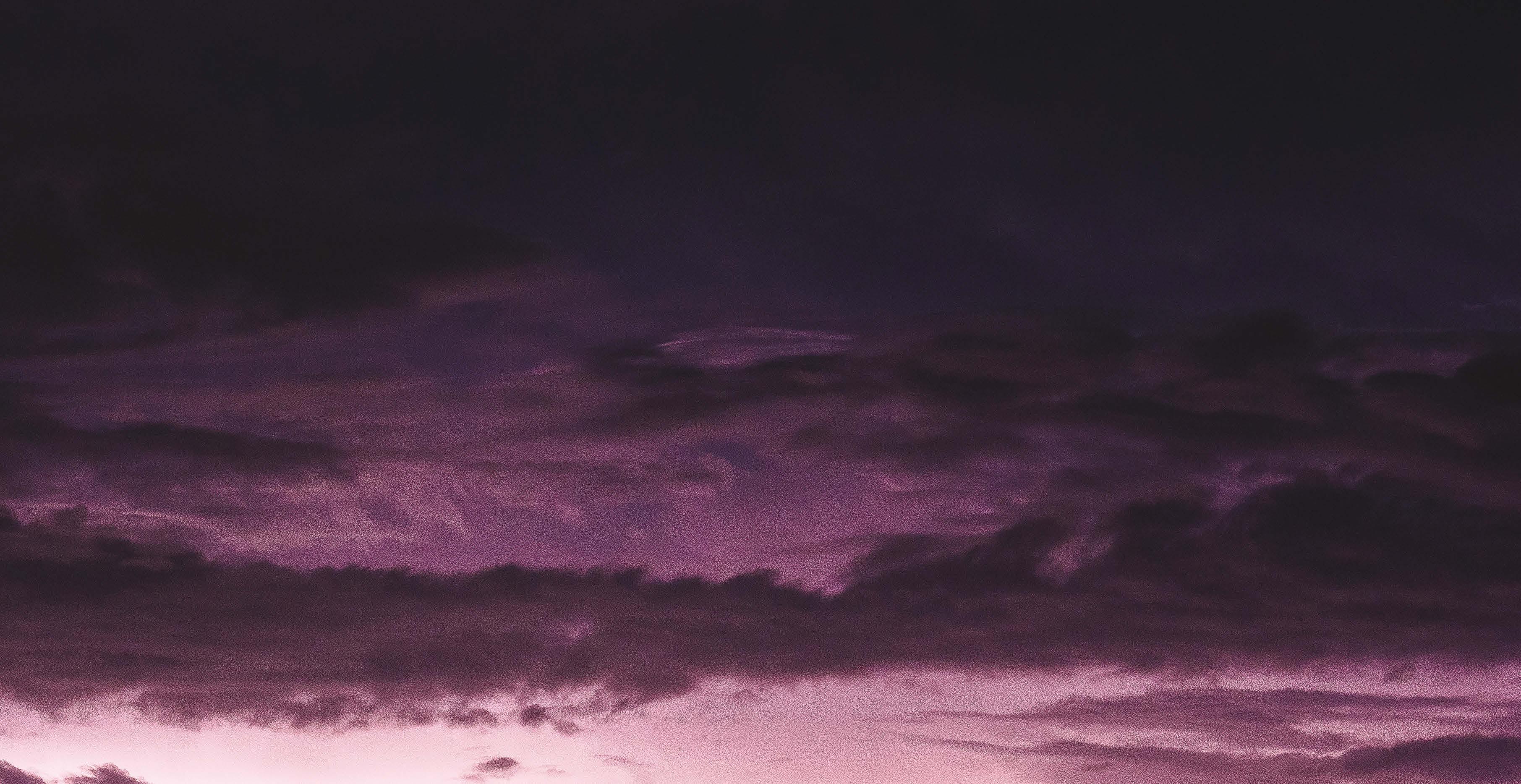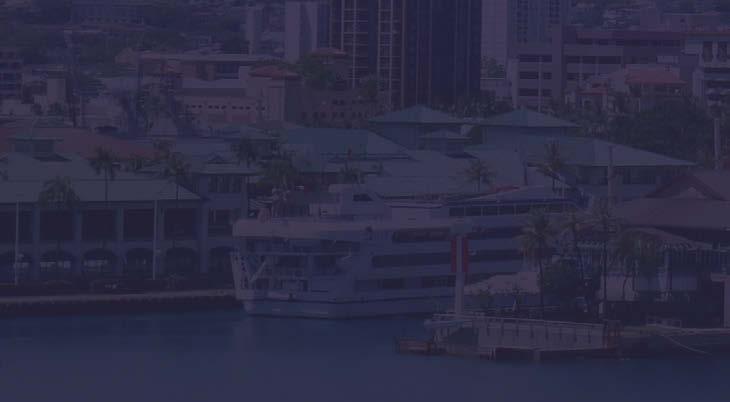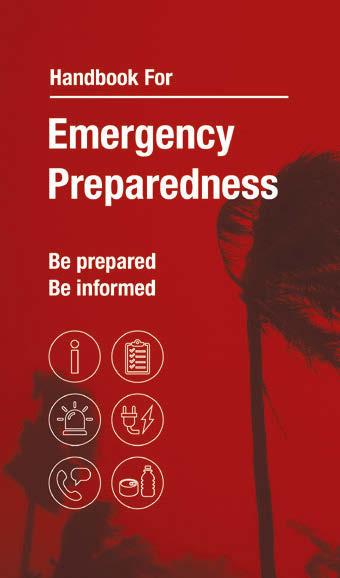

































Island opened its doors over 80 years ago to provide kamaaina with insurance they can trust. Today, as a Top 50 nationally-ranked property and casualty insurer, Island remains true to its local values in service to its customers and communities.






From protecting local businesses of all sizes, to growing families like the Mariotas, Island Insurance is always here to help, especially when you need us most.






Are you ready for whatever Mother Nature throws your way? We’re your destination for all your disaster preparedness needs. We have your supplies, from building materials, generators and emergency kits. We’re here to support you before, during and after emergencies. We’ve got you covered.






aio Media Group 1088 Bishop St., Ste. LL2, Honolulu, HI 96813-3113 HAWAIIHOMEMAG.COM
T: 1-800-788-4230 • F: (808) 537-6455
CYD ROSA | PUBLISHER cydr@hawaiihomemag.com • (808) 534-7537
DARLENE DELA CRUZ | EDITOR darlenedc@hawaiihomemag.com • (808) 534-7160
CATHY CRUZ-GEORGE | EDITOR-AT-LARGE
CODY KAWAMOTO | CREATIVE DIRECTOR codyk@hawaiihomemag.com • (808) 534-7140
JANELLE KALAWE-CHING | ART DIRECTOR
8 Build a Bag
Whether preparing to shelter in place or evacuate, here’s a checklist for your emergency kits.
14
CBS 1500 AM
Learn about the emergency communications hub established by FEMA and aio Hawaii.
16
Trauma-Proof Home
Safeguarding your property — and your loved ones — is critical for emergency preparation.
18
Trauma-Proof Business
Business owners can be ready for disasters with a plan for recovery and continuity.
24
BRANDON
KEN
PATRICK
Indoor Fires Explained
Prevent and manage fires inside your homes, workplaces and schools.
26
Hurricanes Explained
Be vigilant during Hawaii’s storm season by understanding key warnings and procedures.
30
Floods Explained
Explore tips on what to do before, during and a er flooding occurs in your neighborhood.
32
Tsunamis Explained
Huge walls of water can cause ripple e ects with devastating impacts on local communities.
36
Earthquakes Explained
One of Hawaii’s most unpredictable disasters, earthquakes can strike without warning.

39
Courses & Resources
Community support is available with emergency response team training, apps and more.



Presented by aio HAWAII and Island Insurance
Dear readers, community members and service providers:
When aio Hawaii began the process of putting the Hawaii Disaster Preparation Guide together, we had no idea that one of the most devastating events in local history would take place.
On Aug. 8, 2023, a quick-moving wildfire burned through Lahaina, Maui. The beautiful and beloved town was heartbreakingly destroyed. Homes and businesses were lost; we grieved along with the rest of the world for those who did not survive. Relief efforts are ongoing at the time of this writing.
As we send this publication to press, we do so with heavy hearts — but with hope as well. Hawaii’s residents are vigilant, resilient and bound together by the unwavering spirit of aloha. The determination to support one another unconditionally is present in overwhelming grassroots efforts to take care of our Maui ohana with financial donations, supplies and shelter. Our aio Hawaii family of companies is also spearheading ways to bring help and healing.
Getting through a disaster truly takes a village. In compiling the stories and local resources for the Hawaii Disaster Preparation Guide, our sales and creative teams were reminded that a wide network of people and companies is available to answer questions and provide services to ensure well-being and safety for all. We hope you pick up this guide and connect with the experts and organizations featured for your and your family’s needs.
Disasters are devastating, but they don’t have to be defeating. We belong to a community that can help us prepare for, and persevere through, difficult times. Mahalo to everyone who shared in this vision for the Hawaii Disaster Preparation Guide and participated in its production. It’s our honor to provide this valuable resource for Island residents and their families.
Aloha, CYD ROSA Hawaii Home + Remodeling Publisher

crisis could happen anytime, anywhere.


AIn case you need to shelter in place, make sure you have a two-week supply of nonperishable food and water stored.
In case you need to evacuate, have an emergency kit ready to grab and go, filled with supplies that will last 72 hours.







For on-the-road emergencies, store a modified kit in your vehicle and at your workplace.

FOOD
Ready-to-eat meal kits
Granola bars or energy bars
Meat jerkies
Canned vegetables, fruits and meats
Powdered beverages
Dried fruits
Crackers
Peanut butter or nut butter
Mess kit or disposable utensils
Nonelectric source to warm up food, and manual can opener
Small bills are best in an emergency, as vendors may not have change. Place bills in waterproof bags.
CLOTHING
Waterproof jackets with hood
Gloves and scarves
Undergarments and warm socks
Long- and short-sleeved shirts
Long and short pants
Sturdy, covered shoes
Hats and gloves
SURVIVAL GEAR AND COMMUNICATIONS
Flashlights and light sticks
Extra batteries of various sizes
Hand-crank or battery-powered radios (preferably NOAA Weather Radio)
Multipurpose tools (Swiss Army Knife, etc.)
Solar cellphone chargers or hand-crank chargers
Duct tape
Whistles
N95 masks
Work gloves
Waterproof matches
Extra large garbage bags
Tarp or plastic sheeting
Sleeping bag or blanket
Portable tent with carrying case
SANITATION
Portable toilet bucket with disposable liner, and a pop-up changing tent for privacy
Toilet paper (wrapped in waterproof bag)
Waste bags
Feminine hygiene products
Disinfecting wipes for body and hands
Personal hygiene products (deodorant, mouthwash, toothpaste and brush, dry shampoo, etc.)
HEALTH AND MEDICAL
First-aid kit
Prescription medicines
Pain and fever reducers
Insulation blankets
Extra glasses
Hearing aids with backup batteries
Dentures or mouthpieces
Disposable contact lenses, case and solution
Formula and food
Powdered beverages
Diapers and wipes
Clothing
Sanitation and hygiene supplies
Blanket and bedding
Activities and games
Backup of a favorite toy
Portable pet carrier
Identification tags
Dried and/or canned foods
Water for at least one week
Food containers
Leash and harness
Waste bags
Wet wipes
A picture of pet and family (in case pet is lost)
Comfort toys and blanket
Pet first-aid kit
Medicines
Store documents in waterproof, sealed bags.
Copy of passport, driver’s license, school ID, work ID, birth certificate, marriage certificate, proof of address, lease or deed to home, vehicle registration and insurance policies
Copy of family photo and pet photo (in case anyone gets separated)
List of emergency phone numbers


Street and island map
ENTERTAINMENT AND SELF-CARE
Playing cards
Writing and reading materials
Spiritual items (Scriptures, crystals, prayer beads, etc.)
Protect your home, property and belongings with local insurance experts.
PRESENTED BY ISLAND INSURANCElimate change is rapidly impacting weather patterns across the country, leading to extended heat waves, rising sea levels and a surge in extreme weather events as seen all over the news. These weather events are expected to grow increasingly destructive and frequent, so it’s important to make sure that you and your family are prepared.
At Island Insurance, our thoughts continue to be with the island of Maui, and we are committed to supporting Hawaii’s families and businesses. For more than 80 years, our local experts have been there for our customers, including through natural disasters and times of hardship. Based on our experience, here are four proactive things you can do now — before disaster strikes.
1. Take an inventory of your property and belongings.
Take photos or videos of belongings, including furniture, appliances, jewelry and other items. Document both the exterior and interior of your home and car.
Upload this inventory to a data cloud or email it to yourself — that will help to make sure that your information is saved and safeguarded, even if your hard copies and smartphone are destroyed. Having this information can simplify the process of filing insurance claims if any damage occurs during a disaster.

2. Know what your home insurance covers — and what it doesn’t.
Misunderstanding your insurance coverage can leave you vulnerable to being underinsured or, even worse, uninsured. To safeguard your property e ectively, it is crucial to have the right type and amount of insurance. The first step is understanding the di erence between homeowners insurance, hurricane insurance and flood insurance.
To protect yourself from natural disasters, hurricane and flood insurance policies are separate policies that can be purchased in addition to your homeowners insurance. While a homeowners insurance policy usually covers damage from severe weather events caused by fire, wind from a tropical storm, and hail, it does not cover damage caused by hurricanes or floods. A hurricane insurance policy covers wind-related damage caused by hurricanes that a homeowners policy does not. You may also need to obtain a separate flood insurance policy. Flood damage is typically not covered in standard homeowners policies, and hurricane insurance does not extend to flood-related losses. Even properties outside designated flood zones could be susceptible to flood damage during natural disasters.
If you are a homeowner in Hawaii, hurricane insurance is often a requirement for mortgage approval. However, since




not all homeowners obtained their mortgages under this requirement, it is crucial to review your policy and ensure you have the necessary coverage.

Make sure to review and update your policies on a regular basis. Due to inflation and rising property values, insuring your home at the same price it was five years ago may not cover your expenses if it is destroyed in a natural disaster.
3. Don’t forget about your car. When preparing for a natural disaster, homeowners often overlook the significance of taking care of their vehicles. Before a hurricane or tropical storm hits, make sure your gas tank is full or your EV-battery is charged. With the tendency for panic buying and potential shortages during storm warnings, being proactive can save you from unnecessary inconvenience or missing out on gas entirely. Checking oil levels, windshield wipers and tire conditions will also help to keep your vehicle in optimal condition for an extended period of time.
During severe weather, be mindful of where you park your vehicle. If possible, park your car facing out of your garage for a quick and easy exit; or, if parking on the street, avoid spots under trees or powerlines, and try to park close to your home for easier access.
4. Count on your local experts. Did you know that most Hawaii households do not have enough supplies in case of a natural disaster? While the Federal Emergency Management Agency recommends keeping a three-day supply of food, water, and medicine on hand, the Hawaii Emergency Management Agency suggests keeping a 14-day supply of these items due to Hawaii’s isolation from outside resources.
In the event of a natural disaster, contact your insurance agent or company right away to start a claim. If you were evacuated from your home, you do not need to wait to return home to start the claims process.
It’s equally important to take advice from local experts when it comes to your insurance policies. Island Insurance understands Hawaii’s unique geography, climate, and insurance needs.


We know that navigating insurance can be confusing and we’re here to help. Contact us at 808-643-4000 or at www.islandinsurance.com to get started.
For informational purposes. Does not represent insurance contract provisions. For specific information regarding coverages and actual terms, conditions and extensions, please contact your insurance agent. Some restrictions and qualifications apply.













We built Fioptics to be future-proof. That means it delivers performance you can count on, day after day and year after year. And thanks to the advanced network it runs on, Fioptics can evolve with Hawai‘i, providing more speed and bandwidth for all the possibilities of tomorrow.



























































Discover the difference with Fioptics, powered by Hawaiian Telcom.





When natural disaster strikes, it not only poses a threat to ourselves, our families, homes and communities, but also can impact our ability to communicate and maintain access to our digital lives.
We often think about what we need to do to prepare for a natural disaster, but not always about how we will execute on those preparations or the services and tools we’ll use. How often do we stop to consider if our connection can help us prepare quickly and easily before disaster strikes?
Thankfully, here in Hawai‘i we have the option of 100% fiber internet that is brought straight into our homes or businesses, delivered over weatherresistant fiberoptic cables that are also resistant to interference. This advanced technology not only makes digitally preparing for disaster faster and easier, but can also give you the peace of mind of knowing that performance will remain consistent even when many are accessing it at the same time.
When preparing for disaster, time is of the essence. Don’t let your connection slow you down. That’s where fiber internet comes in.

In addition to making sure reliable fiber internet is part of your disaster preparedness plan, here are a couple
things you can do right now — before a natural disaster occurs:

Back up your important personal data to cloud-based services that securely host your files online, including photos of family members and pets, financial documents, medical records, and insurance and property information. Make sure you download and have access to digital copies of any critical documents on your mobile phone, and that they are protected from online threats.
Download apps and follow accounts on social media for trusted information in the event of an emergency. Look for verified accounts or accounts linked from official government websites.
We all hope that disaster never hits, but if it does, be sure that you and your digital life are ready.
Learn more about the difference fiber internet can make for you at hawaiiantel.com/fioptics
 BY CATHY CRUZ-GEORGE AND DARLENE DELA CRUZ
BY CATHY CRUZ-GEORGE AND DARLENE DELA CRUZ
In a community crisis, perhaps the most important point of preparation is knowing where to turn to for reliable, official instructions and information. Communications before, during and after emergencies can be frenetic or fewand-far-between as situations unfold and stressors arise. To keep yourself, your family and your neighbors safe, keep a battery-operated radio handy and tune it to CBS 1500 AM.
“In coordination with our partners at aio, we’ve increased CBS 1500 AM’s ability to continue operating under all conditions, be they natural disasters, acts of terrorism or other man-made events,” says Manny Centeno, project manager, National Public Warning System (NPWS).
In the past, when natural disasters struck and disrupted all communications, radio stations delivered important updates to listeners. But those listeners were out of luck when power outages knocked out broadcast equipment and signals.

The CBS 1500 AM facility was built to be disaster-resistant and is equipped with emergency power generation, ensuring continuity of operations amid adversity. The facility that houses the radio station was built on grounds next to Kahauiki Village off Nimitz Highway in Honolulu. It was constructed with food, bedding and bathroom features aimed at sustaining CBS 1500 AM staff members for more than a month, if needed.
“Broadcast radio, especially AM radio, communicates critical safety information to the public during an emergency and serves an extremely vital role in our nation’s public safety and national security communications infrastructure,” says Centeno.
below: Leaders from FEMA, aio Hawaii and CBS 1500 AM participate in the grand opening and blessing of the emergency broadcast facility near Nimitz Highway in Honolulu.


According to aio Hawaii Chairman Duane Kurisu, the CBS 1500 AM emergency communications hub is in line with aio Hawaii’s overall mission to support the community. Establishing a more resilient radio station offers a pivotal resource for Oahu residents to receive timely messages from the local, state, and federal governments, as well as community organizations. While brief general alerts and warnings may be disseminated quickly on mobile devices in an emergency, CBS 1500 AM will provide key supplemental information and ongoing updates even when the power goes out.
“We are honored to partner with FEMA to offer this vital public service to our community,” says Kurisu. FEMA is looking at ways to possibly expand this service to other islands in the future.
CBS 1500 AM — which currently serves Oahu — is in the same family of aio Hawaii businesses alongside locally owned and operated magazines such as Hawaii Home + Remodeling, Hawaii Business, HAWAI‘I, and HONOLULU. Radio station ESPN Honolulu is also part of the aio Hawaii ohana
To learn more about CBS 1500 AM, visit cbssportshawaii.com

Whether you’re sheltering in place or fleeing for safety, planning is key.
BY CATHY CRUZ-GEORGESafeguarding your home — and your loved ones — is critical for emergency preparation. For most Hawaii residents, that starts with having enough food, water and survival gear.
“Focusing on a 14-day emergency preparedness kit will be the biggest priority if you don’t have that done yet,” says Chris Brenchley, meteorologist in charge at NOAA’s National Weather Service, the Honolulu Weather Forecast Office and the Central Pacific Hurricane Center. “When you have that, next focus on making your home a place you can take shelter in during a storm.”
It’s also important to involve members of your home in your preparations. Some tips:
• Practice: Create an evacuation plan and hold drills. Include your children, elderly members, those with special needs, and pets.
• Communicate: Designate an offisland person to be your household’s contact. If family members on-island cannot connect with one another, that person will be the point of communication for everyone.
• Strategize: In most emergencies, sheltering at home is recommended. But if your home is not strong enough to withstand winds, or if flooding is likely, know how to reach the nearest hurricane shelter and follow evacuation orders. You can also prearrange to stay somewhere safer, with family or friends.
• Be accountable: Although Hawaii communities rally together during disasters, the first line of defense for you and your family is you. A major disaster can disrupt power, communications and water for several weeks before aid is available.
1. Add window coverings (shutters, panels, laminate or plywood) to create a wind- and rain-resistant home.

2. Install hurricane clips to stop winds from blowing away your roof and walls.
3. Retrofit the post and pier foundations below the home to strengthen the foundation and walls.
4. Add impact-resistant glass to protect windows from flying debris.
5. Install bracing to the garage door or replace the door with a stronger one.
6. Regularly trim trees to prevent injuries and structural damage.
7. Store 14-day emergency kits and supplies in a dry, safe spot.
8. Create a safe room in a windowless bathroom or walk-in closet to protect people during an earthquake or hurricane. Safe rooms are not recommended for houses built before 1995, or those located in flood zones or in hurricane or tsunami-evacuation areas.
9. Secure furniture and shelves to prevent collapse during an earthquake.
Stay prepared for natural disasters with reliable gas systems and backup generators.
BY HAWAII HOME + REMODELING STAFFNatural disasters are unpredictable and may strike with little to no warning, causing electricity to fail for days or even weeks. Opening your refrigerator becomes a race to save the cold air, and starting an electric stove is impossible. In times of crisis, the small things are critically important — like refrigeration, hot water, and lights. With a gas system, pipes are
buried, protected from a storm, and will continuously provide power when island-wide electricity is disrupted. It’s a system that allows families to enjoy comfort and necessities like cooking and hot showers while waiting for disasters to subside.
Before a storm, check your gas appliances and grills — they should still work during a power outage. You can also consider getting a propane or nat-

ural gas generator. Homes equipped with gas backup generators are fully functional during most disasters because it is a secondary source of energy for lighting, refrigeration, heating, and other needs.
Take steps today to ensure your home remains functional during a disaster. You can find more information about what to do before, during, and after an emergency at hawaiigas.com.
Protect your employees and assets with these tips.
BY CATHY CRUZ-GEORGEClifton crawford, a swimming-pool developer for nearly 50 years, has seen a few natural disasters in Hawaii. One that he vividly remembers is Hurricane Iniki, which hit Hawaii in 1992.


A crew from his company, Pacific Pool & Spa, had just finished installing a pool and spa at a luxury residence on Kauai. Then “the hurricane came in and physically wiped out the house, knocked out the concrete foundation, took the spa and tumbled it like a big boulder 300 feet away,” he recalls.
As the Islands recovered from Iniki, Crawford’s crew rebuilt the pool and spa the following year. “We reused the spa, picked it up with a crane, and re-leveled the whole area,” says Crawford.
Business owners such as Crawford know that natural disasters are inevitable. Having a recovery and continuity plan is critical — whether the business is a small self-run storefront or a major operation with a fleet of vehicles and employees.
U.S. Department of Homeland Security: Toolkits to get started, ready.gov/business
American Red Cross: Helpful videos and first-aid tips for businesses, schools and organizations, readyrating.org
U.S. Small Business Administration: Checklists and financial assistance, sba.gov
Internal Revenue Service: Information on how to safeguard taxes and monitor assets, irs.gov
U.S. Department of Agriculture: Emergency loans for farmers a ected by natural disasters, fsa.usda.gov
If you’re a business owner in Hawaii, consider these points:
• Minimize disruptions: Is your data stored on a server in a company closet, or backed up on a cloud? Loss of data could wipe out your business. Know how to retrieve information in a post-disaster environment and plan for worst-case-scenarios with your IT department or consultants. Power failures after a hurricane or earthquake are bound to happen. Consider buying backup generators if you haven’t yet.
• Recover losses: How often does your company inventory its floor stock, o ce furniture and other assets? Are your headquarters and branch o ces built to withstand hurricaneforce winds? As the frequency and intensity of natural disasters rise across the globe, business owners are reassessing their insurance policies.
• Communicate intentions: After a disaster strikes, vendors and clients will want to know your company’s status. Inform them via phone calls or text messaging, or post updates on your website or social media channels. The latter was the norm during the COVID-19 pandemic, as local businesses engaged with customers via Instagram, Facebook and other platforms.
• Train employees: Appoint a disasterplanning committee composed of employees and managers. Depending on your company’s size and needs, a disaster plan should address everything from employee safety and IT strategies to supply chains and the company’s reputation. In addition, your committee members should know how to communicate with one another after a disaster — even if power grids fail. One option is to invest in ham radios.
THAT’S A FACT 40%Afteranaturaldisaster, businessesofsmall-tomid-sized neverreopen. Additionally,ittakesmorethan businessesayearfor25%ofshuttered toreopen,accordingtotheFederalEmergency ManagementAgency.

Firsthand advice on first aid and more from Hawai‘i Pacific Health.
BY DARLENE DELA CRUZDr. dale m. glenn, family medicine physician and physician liaison for Patient Experience at Hawai‘i Pacific Health, is no stranger to disasters. He and his ‘ohana were among the many Idaho residents affected by the catastrophic Teton Dam collapse in 1976, when Dr. Glenn was just 7 years old.
“The dam gave way and released a 10-foot tidal wave,” he says. “It was essentially a tsunami on dry land. We went from thriving to total devastation in 24 hours.”
Dr. Glenn, a graduate of the University of Hawai‘i John A. Burns School of Medicine, has practiced medicine in the Islands for more than 20 years. He’s assisted in large-scale emergencies such as Hurricane Iniki, the measles epidemic in Samoa and the COVID-19 pandemic, and is an advocate for empowering the community with disaster prep information.
“You can weather the storms in comfort and not fear,” he says. “You don’t have to panic.”
To start, Dr. Glenn shares the following tips:
1. Have a plan: It’s important to take disaster preparation seriously, as it’s essentially a matter of when, not if, one will happen. Keep a preparedness kit on hand stocked with necessities like a first aid kit, sanitation supplies, important documents, prescription medications and medical equipment/care aids. Don’t forget to include specific items for babies, pets and elderly or disabled family members.
2. Prioritize water, food, shelter: If the power is out long enough — say 24 hours or so — the tap water supply will likely shut down too. Instead of buying bottled water, fill containers at home in an emergency. Stock up on food that
your family will actually eat, and rotate your rations regularly. Map out backup shelter at a friend’s or relative’s home, especially if you have kupuna to take care of. Secure your property if you go on vacation during hurricane season.
3. Carry “an extra supply of aloha”: “During a disaster we’re all going to need to pull together — a sense of community helps to reduce the emotional trauma,” says Dr. Glenn, as we recently witnessed in the statewide community response to the Maui wildfires.
Learning first aid is also key. As long as it doesn’t compromise your own safety or make any injuries worse, you may need to provide medical assistance
to others, which is when knowledge of basic first aid techniques can be critical. Dr. Glenn also recommends familiarizing yourself with tourniquets to assist with bleeding or hemorrhages.
Remember that hospitals are equipped to stay open during a disaster to treat emergency injuries or health conditions. However, they are not shelters. If you live in an evacuation zone, take time to learn where the nearest designated shelter is located, when you need to evacuate and what items you are allowed to bring with you.
So be prepared, for yourself, your family and your neighbors. For more information about Hawai‘i Pacific Health, visit HawaiiPacificHealth.org.
The Hawaiian Islands have been hit by natural disasters before, some of them catastrophic. Here’s a snapshot of a few of them, along with some near misses.

1868
April 2
The largest earthquake in Hawaii’s recorded history, the 7.9 magnitude Kau earthquake on Hawaii Island killed more than 77 people and generated a deadly tsunami off the Puna coast.
April
A 7.4 magnitude earthquake in Alaska triggered an earlymorning tsunami in Hilo Harbor, generating waves up to 45 feet high. The tsunami killed 158 people, including students and a teacher at a Laupahoehoe school. The disaster caused more than $26 million in damage, equivalent to almost $400 million today.
BY CATHY CRUZ-GEORGE1946 1950
Aug. 15-17
Hiki was the first officially recognized hurricane in Hawaii (wind data prior to 1950 was too unreliable to accurately gauge a storm’s strength). The storm generated 90 mph winds and more than 50 inches of rain on Kauai.

 Hilo Tsunami
1
Hurricane Hiki
Hilo Tsunami
1
Hurricane Hiki
A look back at local history reminds residents to stay vigilant.
HILO TSUNAMI (1960):


“I was 12 years old when the tsunami of 1960 struck Hilo. I was home with my family, and I remember seeing on TV that an earthquake happened that generated a tsunami that was going to reach Hawaii. It struck during the night! At a distance, I heard screaming and crashing noises, and the electrical plant exploding. Family members that were evacuated came to stay with us. Always be prepared for anything. You never know when a disaster will hit.”
— Donna Rae Akau, longtime Hilo resident and a retired food service worker and homemaker
Hurricane Iwa, Nov. 23
Iwa arrived in the Islands as a lateseason storm two days before Thanksgiving, with wind gusts over 100 mph. It caused $312 million in damage on Oahu, Kauai and Niihau. The hurricane killed 120 people, knocked out power and left thousands homeless.
Hilo Tsunami, May 23
A 9.5 magnitude earthquake off southern Chile created a deadly 400 mph tsunami that traveled north and west. Approximately 15 hours after the earthquake, at 1:05 a.m. Hawaii time, the tsunami measuring 35 feet high struck Hilo Bay. Sixty-one people died and more than 500 homes and businesses were damaged.
31 & Jan. 1
An estimated 20 inches of rain fell in 24 hours, damaging roads, streams and houses on Oahu; areas particularly affected were Kailua, Aina Haina and Niu Valley. Nearly 3,000 people were evacuated and damage was estimated at more than $30 million.
NEW YEAR’S EVE FLOOD (1988)
“I remember leaving a New Year’s Eve celebration and driving a friend home in Olomana. A huge rain had flooded Kailua. This was before the Kawainui Marsh [levee and flood control project] was built [in 1997]. The water was up to the door of my brand-new pickup truck, and as I was driving through water, I put my hand out the window, and the water touched my hand.”
– Clifton Crawford, President/RME of Pacific Pool & Spa

HURRICANE INIKI (1992):
“Hurricane Iniki was probably the worst we’ve experienced. We were on the North Shore of Oahu. Power was out for a week, and there was no water. I was called to Kauai to assess the damage. When I went there, I saw a coconut tree stuck into the lanai door of a second-floor unit. The pool was covered and full of sand. The sidewalks were lifted, just thrown over, and the forest on the hillsides, up above Poipu, looked like matchsticks on the ground. It was just leveled. That was the most memorable hurricane for me.”
— Fred Lau, owner of Fred Lau Hawaiian Landscape Maintenance Co.
Oct. 15
Two large earthquakes occurred on the northwest coast of Hawaii Island. The first, at Kiholo Bay, was a magnitude 6.7 and was followed six minutes later by a magnitude 6.0 quake at Mahukona. The temblors generated a 4-inch tsunami and caused $200 million in structural damage on Oahu, Hawaii Island and Maui.

Iniki passed directly through Kauai with winds up to 140 mph and gusts as high as 175 mph. The hurricane destroyed more than 14,000 homes, injured more than 100 people and led to the deaths of six people. Iniki caused $3 billion in damage.


Severe rains on Kauai generated a record-breaking 49.69 inches of total rainfall in 24 hours. East Oahu recorded 4 inches of rain per hour. On both islands, more than 500 homes were destroyed by deluges, landslides and flash floods; thousands of residents and visitors were evacuated. The flood caused $125 million in damage.
KAUAI AND OAHU FLOOD (2018):
“A week after the Niu Valley flooding in 2018, I remember one lady so traumatized. We went to help the homes in her neighborhood, and there was 2 feet of mud in her house. I stood in the living room with my rubber boots and asked her, ‘What would you like to throw away? What would you like to keep?’ She looked at me, right past me. She was in shock. So, I picked up one item, ‘Would you like to keep this, or throw this away?’ And picked up another item, ‘Would you like to keep, or throw this away?’ She finally understood. People will be in shock after a disaster. Even if they still have their home, they’ll be in shock.”
— Danny Tengan, member of Aina Haina Prepared, an emergency response team
May-August
Pressure at Kilauea volcano caused the East Rift Zone at Puuoo to collapse, and at the summit, Halemaumau crater grew from 280 feet deep to 1,600 feet deep. The eruption’s lava flow covered key roadways, destroyed 1,839 buildings and damaged 90.

Hurricane Lane
Aug. 22
Lane caused downpours and power outages on Maui and Hawaii Island, which recorded 52 inches of rain in 48 hours. One man died on Kauai after jumping into a stream to save a dog. The storm — which at one point approached Hawaii as a Category 5 hurricane — caused $2 million in infrastructure damage on Maui, and $20 million in damage on Hawaii Island.


Aug. 8
Strong gusts from Hurricane Dora buffeted all islands on Aug. 8, fueling wildfires. A fire in Lahaina, Maui, spread quickly, destroying the entire town. Relief efforts continue.

Keep a close eye on combustibles and learn the right techniques to stop a fire.
BY CATHY CRUZ-GEORGEWe encourage you and your loved ones to regularly review and practice fire safety. On these pages are tips for how to prevent and manage fires in your homes, workplaces and schools.
A fire only needs three things to ignite: heat, fuel and oxygen, known as the “fire triangle.”
• Heat: Examples of heat sources that can ignite fires are electrical currents, cigarettes, lightning, power lines, matches and magnifying glasses used under direct sunlight.
• Fuel: Examples of items that can serve as fuel for fires are paper, clothes, propane tanks, household chemicals, grass and trees.
• Oxygen: Air has about 20% oxygen. A fire only needs 16% oxygen to burn.
How to stop grease fires: Grease fires happen when oil overheats beyond its smoking point and catches on fire. If a cooking pan or grill is in flames, turn o the heat source, then slide a metal lid or cookie sheet over the fire. This cuts o the oxygen source. Do not move the pan, and leave the lid on until cool. Never pour water onto a grease fire — doing so could spark a larger fire. An extinguisher with a “Class ABC” or “Class B” designation will also stop a grease fire.
Class A: The most common kind of fire is fueled by combustibles such as plastics, cloth, rubber, trash, wood and paper.
Class B: These fires involve flammable liquids like gasoline, butane, alcohol, cleaning solvents and lacquers. Class B fires usually occur in industrial areas.
Class C: Electrical fires, often linked to household appliances, machines, motors and wiring, usually start in electrical panels. They can also be caused by overloaded electrical outlets and frayed wires.
Class D: These fires involve burning metals. Examples of combustible metals are potassium, titanium, magnesium and lithium. Class D fires usually occur in scientific labs, factories, warehouses and industrial areas where metalworking is done.
How to stop electrical fires: Do not use water to extinguish electrical fires — it can worsen the fire and even lead to electrocution. Instead, use a fire blanket to smother an electrical fire, pour salt or baking soda onto it, or put it out with an extinguisher labeled “Class C” or “Class ABC.”
Class K: These fires involve cooking oils and fats — for example, overheated bacon grease, butter, lard, olive oil and vegetable oils — that burst into flames. Class K fires typically occur over kitchen stoves, on outdoor grills or inside microwaves.
To use one, remember the acronym “PASS”:
Lights, Wreaths and Trees
Aim the extinguisher at the base of the flame while standing 6 to 8 feet away.
• If a string of lights has loose bulbs or damaged cords, don’t use it; buy a new one.
• Keep holiday trees and wreaths at least 3 feet away from heat sources.
• It’s tempting to leave lights on overnight or when you’re away. To prevent fires, turn o all holiday lights before sleeping or leaving home.
Candles
Instead of real wax candles, consider using battery-operated flameless ones. If you choose to use real ones, please remember:
Squeeze the trigger while supporting the extinguisher with both hands. The fire may temporarily flare up when the agent first touches the flames.
Sweep the extinguisher or nozzle hose slowly from side to side, aiming toward the base of the flame.
• Do not use them in a home with oxygen tanks, which can explode.
• Keep candle flames at least 1 foot away from other objects.
• Use sturdy candleholders that will not fall over or melt.
When working with extinguishers, remember:
• Only 15 seconds of material will discharge from a 10-pound extinguisher; less than 30 seconds of material will discharge from a 33-pound extinguisher.
• When the gauge’s arrow no longer points to green, it is time to replace or repressurize the extinguisher.
• Fire stations do not accept used or old extinguishers; dispose of them at a recycling center, not in the regular trash.
• Blow out candles, and never burn them in unattended rooms.
• Keep matches and lighters away from children.
Fireworks
To purchase firecrackers on Oahu, you’ll need a permit from the Honolulu Fire Department. Aerials and pyrotechnics are illegal on Oahu.
Stay vigilant during Hawaii’s storm season.
 BY CATHY CRUZ-GEORGE
BY CATHY CRUZ-GEORGE
See page 8 for tips on how to build an emergency bag.
hurricane is a tropical weather system with a distinct circulation pattern and maximum sustained winds of 74 mph or higher. Before the system reaches hurricane strength, it passes through di erent stages: A tropical depression is the first stage, when the storm’s maximum sustained winds reach 38 mph. It is upgraded to tropical storm status when maximum sustained winds range between 39 mph and 73 mph.


All three systems bring intense rains, thunderstorms and circulation patterns. Storms coming from the south typically cause the most damage.



The Central Pacific Hurricane Center on Oahu tracks and issues alerts for tropical cyclones in the region. Be familiar with these alerts:
Hurricane Watch: A hurricane could arrive within 48 hours. Check for status updates on mobile devices, radio or TV. Have emergency kits ready. Prepare to evacuate if necessary.
Hurricane Warning: Hurricane conditions are expected to arrive in less than 36 hours. Shelter in place or evacuate to a structurally sound building. Continue to listen for the Statewide Outdoor Siren Warning System or Wireless Emergency Alerts.
In addition to strong winds and thunderstorms, hurricanes bring another dangerous condition called storm surge. Storm surge is an abnormal rise in ocean water caused by winds pushing water onshore. The influx of water can reach hundreds of miles inland and create treacherous waves over 20 feet high. Hurricanes typically pass near — or rarely, directly through — the Hawaiian Islands each year between June 1 and Nov. 30, otherwise known as the Central Pacific hurricane season. The number and severity of hurricanes depend on several factors, including ocean temperatures, wind flow and cyclical weather patterns.
BEFORE




• Fill vehicle gas tanks and park vehicles away from trees and objects that could topple.
• Withdraw cash, in addition to the cash already in your emergency kits.
• Secure outdoor items, awnings and large objects that could fly in high winds; protect windows with plywood or other materials.
• Set freezers and refrigerators to the coldest settings in case of a power outage.
• Move hazardous materials, including propane tanks, away from heat.

• Shelter in place if your home has been retrofitted to withstand hurricane conditions, or if it was built after 1995 and meets code.
• Evacuate if your home has not been retrofitted for hurricane conditions; also evacuate if your home is a wood-framed, singlewall structure built before 1995.
DURING AND AFTER
• Continue to listen for Wireless Emergency Alerts and the Statewide Outdoor Siren Warning System.
• Stay away from doors and windows, and keep them closed.
• Use text messages instead of phone calls. Do not overload circuits by using telephones unnecessarily. Phone lines are for emergencies and emergency workers.
• The “eye” of a hurricane brings temporary calm to a storm. Wind and rain will stop for a period, and then resume once the eye passes. Continue to shelter indoors during the eye of the storm.
• When the hurricane has passed, cautiously exit and note your surroundings for hazards, including broken glass and structures, and downed power lines.
13 TIPS: BEFORE, DURING AND AFTER A HURRICANE














Hurricanes are rated according to their sustained wind speeds and potential damage to property. Below are numerical categories — from 1 to 5 — known as the Saffir-Simpson Hurricane Wind Scale:


74-95
Power outages. Damage to power lines and poles. Snapped branches and palm-tree fronds. Structural damage to older homes. Very dangerous winds.
96-110
Water and power outages for several days. Weaker homes at risk of damage to roofs, doors, windows and siding. Uprooted or downed trees. Extremely dangerous winds.
111-129















































































































Power and water outages for weeks. Larger trees toppled. More than half of palm fronds blown away. Damage to smaller, sturdy homes. Devastating winds.
130-156
Power and water outages for several weeks or months. Communities cut off by downed poles and large trees. Major damage to nonconcrete buildings and roofs in general. Eroded shores. Blown-out windows due to wind pressure. Catastrophic damage.






































Power and water outages for several months. Major flooding near the shore. Destruction of nonconcrete buildings. Uninhabitable neighborhoods. Only four Category 5 hurricanes have made landfall in the U.S.






























Answer: No difference, except their locations. Both produce strong winds and rain. Hurricanes are in the North Atlantic and Northeast Pacific. Typhoons are in the Northwest Pacific Ocean. Comparable storms in the South Pacific, Indian Ocean and South Atlantic are often referred to as tropical cyclones.



The NationalWeather Service sends mobile alerts to warn of floods.Signupforfreeat hnl.info/starter

Rising waters can cause significant property damage and injuries.
 BY CATHY CRUZ-GEORGE
BY CATHY CRUZ-GEORGE
The hawaiian islands are vulnerable to floods caused by hurricanes, tsunamis and excessive rains, as well as dangerous flash flooding when heavy rain falls in a short period of time.
Know the Flood Alerts:
• Potential floods could a ect low-lying areas, underpasses, storm drains and streets. Listen to o cial alerts for updates.
• Flood Watch: A flash flood is possible. Plan to evacuate or move to higher ground. Listen for further notices.
• Flood Warning: A flash flood is expected or is happening. Seek safety.
• 6 inches of water is enough to stall a moving vehicle.
• 6 inches of fast-moving water is enough to carry away an adult.
• 12 inches of fast-moving water is enough to wash away a small vehicle.
• 18 inches of water is enough to carry away a large SUV, truck or minivan

• Have an emergency plan that includes roles and directions for all family members. If you have to evacuate the area, know where to go and how to get there.
• Build a 14-day kit. Inventory the items in your home; keep digital copies of records.
• Be aware of flood risks to your home, school and workplace. Take note of nearby drainage channels, streams and areas that could flood.
• Immediately evacuate to higher ground (including moving to a building’s upper levels if you live in a high-rise); or shelter in place if instructed to do so.
• Remember the motto, “Turn Around, Don’t Drown!” and do not attempt to drive, swim or walk through a flooded area. Bridges located above fast-moving water are prone to collapse and should be avoided.
• If you’re in a vehicle, stay inside and shut all windows and doors. If the water rises, climb onto the vehicle’s roof.
• Shut off the electricity if it’s safe to do so and avoid electrical items that are wet. Don’t risk electrocution.
• During the recovery process, guard your health with waterproof clothing, gloves and personal protective equipment such as masks and face shields.
• Inventory the damage to your home and property.
SOURCES: AMERICAN RED CROSS; CITY & COUNTY OF HONOLULU
DEPARTMENT OF EMERGENCY MANAGEMENT; AND U.S. DEPARTMENT OF HOMELAND SECURITY
• Make sure your portable propane tanks are full and in good working condition.
• Check to see if your propane tanks are firmly secured.

• Consider a backup propane or gas generator that can supply electricity if the power goes out.
• Schedule a refill of your permanently installed propane tank if it’s less than 30% full. For cylinders, make sure your backup tank is stocked too.
Huge walls of water can flood communities and cause ripple effects with devastating impacts.
BY CATHY CRUZ-GEORGEAtsunami is a series of long ocean waves triggered by an underwater landslide, earthquake or volcanic eruption. Tsunamis can be dangerous — even deadly — as these waves can travel up to 500 mph from their points of origin before making landfall. Tsunamis slow down when they reach the
coast; waves there can be up to 30 feet long and their waters can travel up to 10 miles inland.
To stay safe, it is important to know which Hawaii neighborhoods are in the green (safe), yellow (moderate risk) and red (high risk) areas of the Extreme Tsunami Evacuation Zone.
The Pacific Tsunami Warning Center, located in Honolulu, collaborates with the Alaska-based National Tsunami Warning Center to track tsunamis and send alerts. Be familiar with the tsunami alert levels.



Tsunami WATCH: An underwater earthquake or landslide has been detected. There is no immediate threat of a tsunami. Be prepared for more alerts.

Tsunami ADVISORY: A tsunami could arrive. Evacuate low-lying areas or prepare to leave. Stay out of beaches and waterways. Listen for status alerts.
Tsunami WARNING: A tsunami is on its way. Immediately evacuate lowlying areas in the tsunami evacuation zone, or head up to the fourth floor (or higher) of a building that is more than 10 stories high. Follow instructions if you’re on a boat or in deep water.
Alaska (1946 Aleutian earthquake)
Japan (2011 Tohoku earthquake)


South America (1960 and 2010 Chile earthquakes)
Smart choices start now, don’t wait until disaster strikes! Minimize the impact of storms with our year-round property maintenance program. Discover our professional risk assessment


We are fully insured for your peace of mind. We respond swiftly to your urgent needs. Your mulch is donated to local schools and farms.


With 30+ years of mastery, we’ve earned 30 awards for unwavering excellence, crafting a legacy that shines. Trusted by 6,800 clients, we’ve elevated the industry standard with 3,500 repairs and 3,000 projects. Your visions ignite our mission—24/7, we bring dreams to life, from emergency repairs to upscale upgrades.


Be ready for one of Hawaii’s most unpredictable disasters.
BY CATHY CRUZ-GEORGEBetween 5,000 and 10,0000 earthquakes occur in hawaii every year, according to the Hawaiian Volcano Observatory. However, most are so small only seismometers can detect them.
Earthquakes in the Islands are classified into three types: mantle, in which the weight of the Islands causes bending and flexing of Earth’s crust and upper mantle; volcanic, in which magma moves in and around active volcanoes; and tectonic, which are earthquakes that occur along faults in the upper mantle and crust.
There are two ways to measure an earthquake:

• Intensity refers to the shaking that is felt and the damage that is caused. The intensity of an earthquake will be different depending on how far away the epicenter is.
• Magnitude refers to the size of an earthquake and the ground motion that is recorded by a seismometer. Various methods, including the Richter scale and the moment magnitude scale, are used to calculate magnitude. A magnitude of 3 or less won’t be felt by everyone, but earthquakes with magnitudes of 4 and higher can cause considerable damage.
Did you feel an earthquake?
Report your experience to the website, “Did You Feel It?” which creates maps of earthquakes based on collected information from people around the world. Bookmark the website at earthquake.usgs.gov/data/dyfi
For years, people have tried to predict earthquakes by, among other things, observing animal behavior, groundwater shifts and electromagnetic readings in the upper atmosphere. These methods are not scientifically accurate, however, and predicting earthquakes reliably has been elusive.
Geologists today can, at best, pick up on the potential of an impending earthquake using ear-
ly-warning systems comprising ground-based sensors. When seismic activity is detected, alerts are sent and people located near the epicenter have seconds to seek safety. Large earthquakes usually are followed by aftershocks, which geologists can forecast using calculations based on seismic patterns. As technology continues to advance, methods such as machine learning and deep learning will be used to better understand earthquakes.
• Drop to the floor, seek shelter under a sturdy desk or table, and hold on until the earthquake stops.

• If you’re inside a building, avoid windows, tall shelves and items that could fall. Protect your head with a pillow if you’re in bed.
• If you’re on the beach or in a designated tsunami zone, move to higher ground or inland as soon as the shaking stops. Stay in an area that is at least 100 feet above sea level.



• If you’re outdoors, avoid heavy objects that could fall — construction equipment and wooden poles, for instance.








• If you’re in a vehicle, come to a stop. Avoid parking on or near bridges, or near heavy objects that could topple onto your vehicle. Remain inside your vehicle until the earthquake stops.

The Great Hawaii ShakeOut, which happens annually on the third Thursday in October, is part of an international drill to prepare for an earthquake at home, schools and workplaces. Learn more at shakeout.org/Hawaii
Get trained on disaster preparedness and stay informed with key communications outlets.
BY CATHY CRUZ-GEORGECommunity emergency response team training helps you to operate safely in a disaster zone until first responders arrive. Free training — sponsored by the City & County of Honolulu and the Department of Emergency Management — includes 16 classroom hours, plus four hours of field exercises. Once trained, you can join an existing CERT team or build your own community response team.
Topics Covered:
• Search and rescue
• Emergency triage and first aid
• Periodic reporting to the City & County of Honolulu
• Damage assessment

• Evacuation
• Small fires
• Identifying and helping people with access and functional needs
• Warning and notification
• Emergency utility control

• Preparedness
above: Community Emergency Response Team training empowers civilians to learn techniques and protocols to assist others and stay safe before first responders arrive.

Learning
First aid, CPR and AED courses are available at the AED Institute of America and the American Red Cross of Hawaii Classes are taught in person or in a hybrid format. Instruction and certification fees are $80 and up.
• CBS Hawaii: CBS 1500 AM
• KSSK Radio: KSSK 590 AM
• Hawaii Public Radio: KHPR 88.1 FM, KIPO 89.3 FM
• Krater 96: KRTR 96.3 FM
• KZOO Hawaii (Japanese): KZOO 1210 AM

• KREA (Korean): KREA 1540 AM

• KNDI (Filipino and Chinese dialects, Laotian, Okinawan, Vietnamese, Samoan, Tongan, Marshallese, Chuukese and Pohnpeian): KNDI 1270 AM
• NOAA Weather Radio: On Oahu, NOAA Radios receive National Weather Service alerts 24 hours a day on radio frequencies 162.450 (channel 3, WWF39, Hawaii Kai) and 162.550 (channel 7, KBA99, Mount Kaala)





Red Cross Emergency: “Emergency,” an all-hazard app from the American Red Cross, provides weather updates, shelter information and interactive maps. The “I’m Safe” feature allows users to alert others that they are safe.

FEMA: The Federal Emergency Management Agency’s app provides real-time weather alerts for your selected geographic location. Postdisaster weather advice also is available. In addition to finding the app through Google Play and Apple, you can download it via text messaging — for Android, text ANDROID to 43362 (4FEMA); for Apple, text APPLE to 43362 (4FEMA).
City & County of Honolulu (HNL Info): Receive alerts related to emergencies, weather and local traffic situations.
Ready Kids: “Ready Kids” from the U.S. Department of Homeland Security offers child-friendly resources, kids games and emergency-planning tools for teens. ready.gov/kids
Keiki Activity Book: Hawaiian Electric Co.’s downloadable booklet, “Maka the Safety Superhero,” teaches young children about staying safe in emergencies. https://www.hawaiianelectric.com/safetyand-outages/storm-center/emergencypreparedness-handbook
American Veterinary Medical Association: The American Veterinary Medical Association provides a pet evacuation checklist and tips for helping pets recover from a disaster. https://www. avma.org/resources-tools/pet-owners/ emergency-care/pets-and-disasters
Older Adults by the American Red Cross: The American Red Cross’ downloadable emergency checklist and booklet are designed for older adults and their needs. https://www.redcross.org/ get-help/how-to-prepare-for-emergencies/ older-adults.html






Board of Water Supply boardofwatersupply.com/prep
City & County of Honolulu

Department of Emergency Management

honolulu.gov/dem
Hawaii Emergency Management Agency ready.hawaii.gov
Hawaiian Humane Society hawaiianhumane.org/disasterready
Hawaiian Electric Oahu Power Outage Map (Oahu)
https://www.hawaiianelectric. com/safety-and-outages/poweroutages/oahu-outage-map
Twitter: #OahuOutage



















IT disaster recovery involves an organization's strategies for restoring its IT infrastructure and operations following a disruptive event, like a hurricane or cyberattack. This crucial aspect of business continuity safeguards productivity, revenues, and reputations.

Protect data. Develop a robust data backup and recovery strategy to minimize data loss and downtime.

Evaluate IT assets. Inventory your hardware and software assets and rank them by criticality to operations.
Assess risks. Start by assessing potential risks and their impacts to your organization and its IT environment.
Plan communications. Prepare effective channels for crisis communications, and identify who, what, when, and how.

Prioritize people. Remember to prioritize the health and safety of your employees, your most valuable assets.
Develop a plan. Write clear, concise, and actionable instructions for each step of the recovery process.
Educate employees. Ensure your employees understand their roles in effectively executing the recovery plan.
Hawaiian Electric works in close partnership with county Civil Defense agencies, Emergency Management departments and the Hawai‘i Emergency Management Agency during emergencies.
In an emergency, these tips can help you avoid danger: Never touch downed power lines, stay at least 30 feet away | If evacuating your home, turn off your electricity at the main circuit breaker or switch.
Home survival kits are essential during disasters and should include: 14-day supply of food and water for each person and pets/ service animals | Nonpershable foods | Portable radio | Cell phone with backup charger | See more in our Emergency Checklist.
Put together an Evacuation Kit that includes: Sleeping bags or two bankets per person | Clothing for each family member | Important papers and documents | Where to meet if separated
Make sure your First Aid Kit includes: Current medications with prescription information | Bandages and band-aids | Hand sanitizer | Soap | Adhesive tape | Scissors and more

A communication plan for your family should include information on the multiple ways you can contact one another. Your plan should include: Personal Information | Emergency Family Contact | Out-of-State Contact
Preparation will help you and your family stay safe. Use these resources to be informed and report trouble.
> Download the Emergency Preparedness Handbook at hawaiianelectric.com/safety (Different languages are available.)



> To report downed power lines/items touching power lines, call our 24/7 Trouble Line: O‘ahu: 1-855-304-1212 | Hawai‘i: 808-969-6666 | Maui: 808-871-7777
Moloka‘i and La - na‘i: 1-877-871-8461 toll free
Stay connected with us